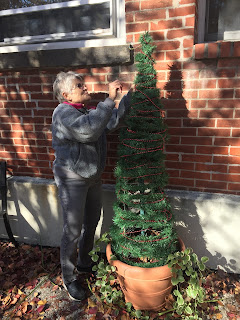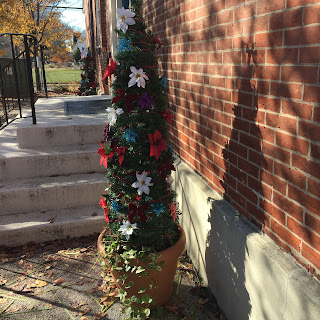I've
always thought of myself as being passionate about gardening and
based on the results of the online quiz, “Whats your garden style?”
(www.quibblo.com/.../What-is-your-garden-stylem),
I am! According to this quiz, gardening (for me) is an all
encompassing way of life, continuously on my mind, working towards
self sufficiency. From heat to weeds, I enjoy it all. It allows me
to connect with nature, and to “just be” in my happy place.
Have
you ever given thought to how you would describe the look of your
gardens? When it comes to my own I would describe them as a bit
willy nilly. So, I took the quiz, “What's your garden personality”
by Canadian living
(www.canadianliving.com/home-and-garden/article/quiz-what).
The
results? The garden style that best fits my personality is an English
cottage garden. This style of gardening is not for those who play by
the rules. Anything goes and you will try at least once, twice maybe
three times (insanity or determination?) something new. The English
cottage garden is informal with a blend of ornamental, annuals and
edibles such as herbs, fruit trees and vegetables.
Are
you familiar with the name Capability Brown? If so, you may be able
to call yourself a “pro gardener”. When you are not toying in
your garden then most likely you are at the local garden center where
as in the show “CHEERS” everybody knows your name. You may not
think that you are an expert but take this quiz from stuff.co.nz
(www.stuff.co.nz/.../Whats-your-gardening-personality
) and find out if you garden like a pro! And Capability Brown, he
was a landscape architect from 18th century and considered
England’s greatest gardener.
If
you would say that your method of weed control is to pull them out,
the sunflower is your first choice when it comes to annuals and you
know what the word “bolting” means then you are truly a “green
fingered gardening god”
(www.playbuzz.com/.../whats-your-gardening-personality).
You may own a half dozen pairs of gardening gloves but you have no
trouble digging into the dirt with your bare hands!
If
you do wear gloves then you may be interested in this quiz by The
Garden Glove (www.thegardenglove.com/quiz-what-is-your-garden-style/
). Take this five question quiz to learn what garden style is right
for you and tips on how to create it.
If
you answered with mostly A's, then you enjoy a “Nature Lovers
Garden”. You love mother nature and take your cues from her.
Your garden is not traditional and a bit wild. The emphasis may be
on native plants but there is still a lot of creativity.
A
Modern Garden (mostly B's) focuses on “less is more” and keeping
things simple. The use of repetition in plant choices, color and
plant placement puts the focus on hardscaping, form and texture.
I
answered with mostly C's which resulted in the “Country Garden”
Not as wild as a nature lovers garden the country garden is informal
and tend to be a mix of many different types of plants but with a
feeling of uniformity. The country gardener is always learning, not
afraid to experiment nor are they afraid to change things up as
needed.
French
formal gardens are best viewed from a distance and usually includes
straight lines of precision cut hedges, square beds, a water
feature, statues and brick or stone pathways to give it a sense of
order. If this is more your garden style then you answered with
mostly D's.
Believe
it or not, Sears has a quiz: What's your garden design style?
(www.searshomeservices.com/blog/quiz-whats-your)
Regardless
if you are new to gardening or have been at it for a long time, this
quiz will reveal if English Cottage, Asian-Inspired, Modern or Eco-
Friendly expresses your inner gardener.
I
was unaware that there are different types of gardeners so I took the
quiz “What type of gardener are you?
(www.proprofs.com/quiz-school/story.php?title=NjI)
The results “Vegetational Deity”. (Vegetational of or
pertaining to vegetation and deity, god or goddess). My garden is
my domain and a representation of who I am. I will not hesitate to
pull out plants that disappoint, move plants about the garden as
needed and spend endless hours striving for perfection never to be
satisfied. Based on this description it appears as if there is no
end in sight!
For
added fun (why not) I took the quiz “What's your mulch
personality?” (www.bhg.com) Being a “true gardener” I prefer
compost as my mulch of choice. What other kinds are there?
Lastly,
the garden style quiz by Monrovia (www. monrovia.com)
is designed to help you find which garden inspiration best fits
your lifestyle. The results “Echo Friendly Garden” describes all
Master Gardeners. It's principles are:
1.
Go green by composting yard waste and kitchen scraps, reuse,
re-purpose and recycle when ever possible, and water wisely.
2.
“Do no harm” by going native, removing non- native, invasive
species and avoiding the use of pesticides, herbicides, and chemical
fertilizers.
3.
You love this planet and give back by providing food, water and
shelter for pollinators and work with mother nature to create a
friendly wildlife habitat. You also give back by volunteering your
time in the community.
Explore
the wold of gardening with on line self assessment quizzes and see
how your garden grows!







